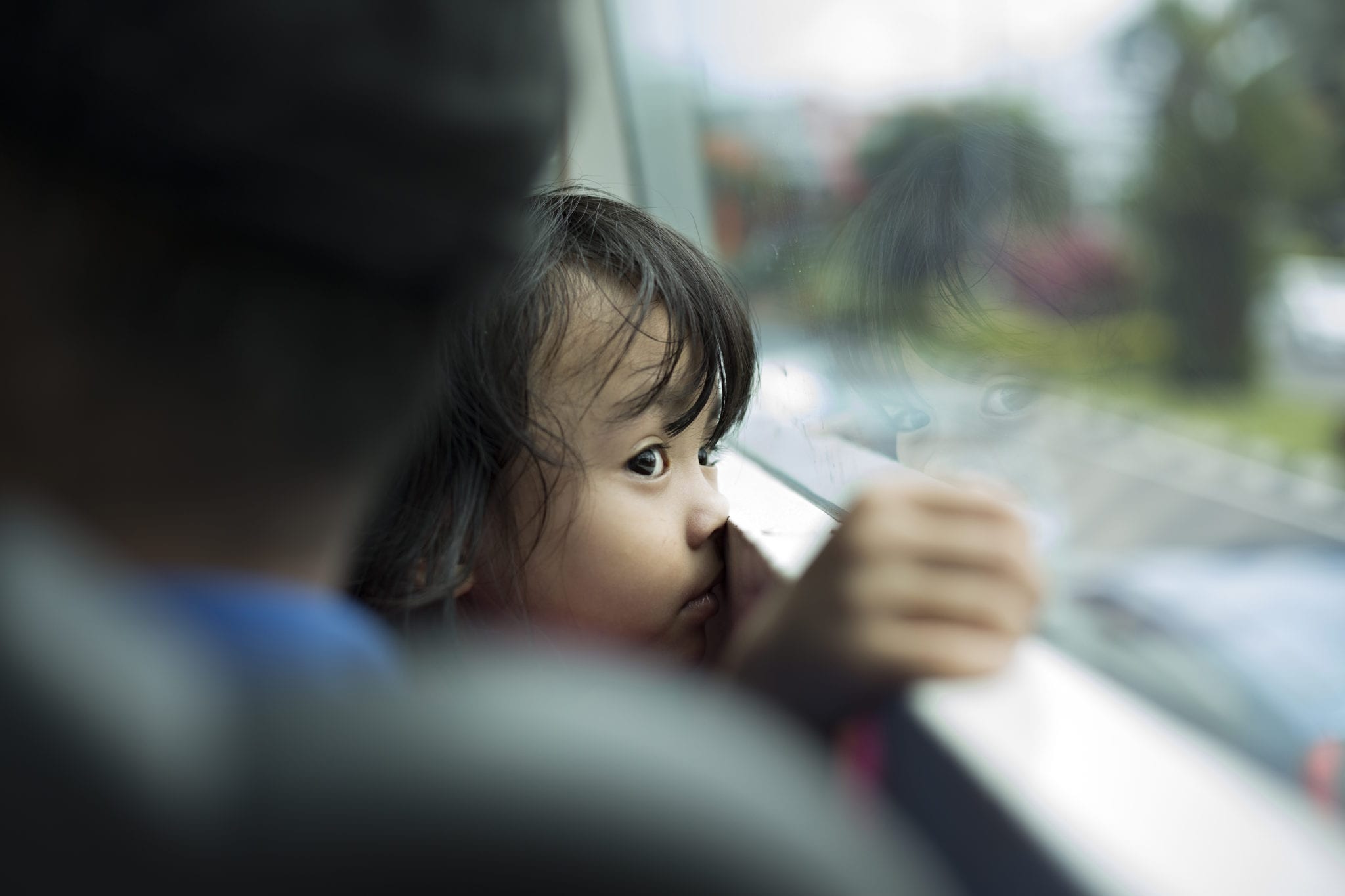On our final night in Kuching, and in Borneo as a whole, I’m sitting here thinking back on our time in this city. We’ve revisited our favourite spots today for lunch and dinner (kolo mee next to the Hainan Association and Asia Fashion House; mee sapi and beef satay at Green Hill Corner), and I spent two thrilling hours back at Semenggoh this morning.
We went out to Santubong yesterday; Rich climbed a mountain for six hours (I’m still questioning his sanity) while I hung out on the lovely little stretch of beach. Nice. Simple. Oh, and we finally had our first (well, second) full-fledged miss on the food front, after the odd sweet-glutinous-cake-and-boiled-egg filled pasty from a week ago. This time, it was a lovely-looking square made of milky rice and topped with opaque green jelly. After his prior experience, Rich correctly identified the jelly as pandan, and I assumed that the milkiness of the rice was from coconut. Well. You know what they say happens when you assume… When I tried the squares for the first time, I had the “pleasure” – and I use that word very loosely here – of sinking my teeth into rice so salty it felt like a mouthful of seawater. This was quickly followed by a moment of acting like a four year old who tried to see how fast she can empty the contents of her mouth onto the ground. Lots of muttering and tongue flapping while I tried to get all of the salty bits off my tongue. Gross! I then spent the next four hours relishing the fact that I was going to get to be the one to share this newfound treat with Rich once he came down off the mountain (note: it was every bit as entertaining as I’d hoped; Rich was suitably unimpressed with both me and the little green delicacy). Then a group of us converged on a food hall for dinner in one of those odd moments where a number of independent individuals suddenly gels into a unified group, if only for an evening. I left Rich with the others and called it a night, knowing I had another early morning because I was going back to Semenggoh. Unfortunately, someone in the building across the street seemed to be attempting to kill every cat in Christendom (made all the more impressive by the fact that we aren’t even in Christendom) under the guise of what is supposed to be called “karaoke”. I continue to marvel at the number of unashamedly HORRIFIC karaoke singers who seem constantly available for full-volume serenades in this country. Is there a “tone deaf gene” that has yet to be mapped?
Four very short hours of sleep later, and I was once again questioning the wisdom of my decision to wake up early, but I hauled myself out of bed and out to the bus street in time to board the bus to Semenggoh. As you may have read last week, our first experience with the orang-utans was a quiet, peaceful, but exciting morning. This was anything but quiet or peaceful. Yet again, I was met by three orangs – seemingly three generations, with Grandma even walking like an aged human – within minutes of arriving in the main yard; they came strolling silently down the road behind me. With no one else yet in the area (not even the staff), it wasn’t much of a struggle to find a good angle to stop and enjoy their presence. The peacefulness of the moment was short-lived. The trees were rustling behind the staff area and the forest was alive with the sounds of various orangs grunting in what, we were told, was less-than-friendly conversation. It was clear that something else – something VERY big – was back there and he wasn’t too happy. It looked like I was going to get to meet Ritchie.
While the others made impressively stealth entries, the same cannot be said for Ritchie. A creature this large cannot move in complete silence – nor, it seems, does he care to. He was perfectly content crashing through branches, rattling trees as it suited him, and when he finally came fully into view, he was, quite simply, breathtaking. It’s hard to imagine just how big a mature male orang-utan might be; hard, that is, until he’s right there in front of you, in all his terrifyingly large glory. When the trees were shaking like a Christchurch home, the guides knew we were in for a busy visit and by the time he touched down on the ground, they were almost frantic in their efforts to ensure our safety. A male this large has a temper to match, it seems, and the guides are very cautious when Ritchie is on the ground. To be honest, I was quite thankful for this; a few of the observers seemed a little too comfortable in the presence of this magnificent animal and didn’t understand the risks they were taking by attempting to get too close.
Ritchie wasn’t on the ground for too long; he had his sights set on romance and pursued one of the females (and her toddler) up a tree. The female looked none too impressed, and I can’t say I blame her. Something tells me that, although orang-utans are known to actually romance one another, Ritchie might not be prone to using much finesse when it comes time to follow the urge to procreate. Watching the pursuit was fascinating, purely because I was impressed to see how something so big can get around so easily. The trees surrounding the centre vary in diameter from 2″ to perhaps 12″. Imagine the effect of Ritchie, essentially a six-foot, 250ish lb superhuman, on these trees. He doesn’t “climb” from tree to tree; he puts all of his weight into leaning one direction and the tree bends to his will, allowing him to simply step from one tree to the next in a form of ballet that embodies every meaning of the word “awesome.”
The rest of my two hours passed in a blur of orange hair and rustling leaves. Even before 8:30 – a full half hour before the tour groups arrived – we’d seen a half dozen or more orangs and more seemed to be coming at every turn of the head. A mother and infant to my right; the initial mother and her “toddler” in front of me; a young male doing an interesting suspended cartwheel down the rope above us to our left; Grandma chilling out by herself behind me and to my right; another young one racing down the rope along the back perimeter; the mother and newborn from last week’s visit along with two young individuals over in the woods at another feeding platform… At times, it was almost impossible to know where to look. By morning’s end, I’d completely lost count of the final tally and knew that it no longer mattered. Somewhere between orangs 8 and 10 I knew that this was an experience I’d never be able to replicate – and more apes were still popping out of the foliage. By the time the guides politely sent us packing, I was more excited than Augustus Gloop beside the chocolate river, and couldn’t wait to get back to town to tell Rich about my adventure while we feasted on kolo mee for lunch on our last day in Borneo.
Kuching has been our base since the 22nd – a full eight days and nine nights. In that time, we’ve made ourselves feel at home: the women at the kolo mee stand greet us like friends; we recognise the iced coffee woman from the not-open-air “open air” market while we’re in line at the bank; the weathered and perpetually shirtless old man who owns the propane tank shop down the street greets us with a wave of almost Nazi-like enthusiasm each time we pass; we’ve begun to recognise the regulars at Good Corner Coffee Shop; Rich has made friends among the members of the Kuching Rugby Club. These little gestures are what make us, as travellers, feel that we’ve come to know one place better than another.
Steve, a loud and vocal (those two chosen adjectives implying two distinctly different traits) American photographer whose presence at the guest house I have mentioned before, commented that he felt he’d captured what he needed of Kuching in two portraits. The more I thought about this, the more I wished I’d had the presence of mind at the time to ask what it was that he’d photographed that made him feel he’d covered the bases, because I couldn’t agree less. Did he capture the men, both young and old, sitting outside the various Chinese community associations? What about the tinsmiths on Lower China Street? The carpenters on (not-so-creatively-named) Carpenter Street? How about the children, playing quietly in the shops while their parents go about their daily work? The moments shared between travelers over guitars and stools-cum-drums outside an internet cafe? And the cramped, over-heated chaos down the side streets along India Street – any moment of that on film?
Kuching invites you to fall into a simple routine: get up when you feel ready, nip out for noodles or rice for breakfast, have a little wander during the cool of the morning to collect some snacks to get you through the day, do a spot of people watching before finding lunch, after which you retire to the hostel to seek shelter – and perhaps a siesta – during the cloying, overwhelming heat of the midday sun, then resurface to find somewhere to go for an iced drink, and then dinner and maybe a beer or two. If you don’t make any effort, this routine – so easy and comfortable – will rapidly become a bore and you’ll lose sight of those details that make Kuching more than just another city; those details are what add character to an otherwise pleasant, pretty and simple city.
So, to Steve and others who perhaps lose sight of the trees because of the forest, keep looking. There’s plenty to see.
Grateful for: KOLO MEE!









